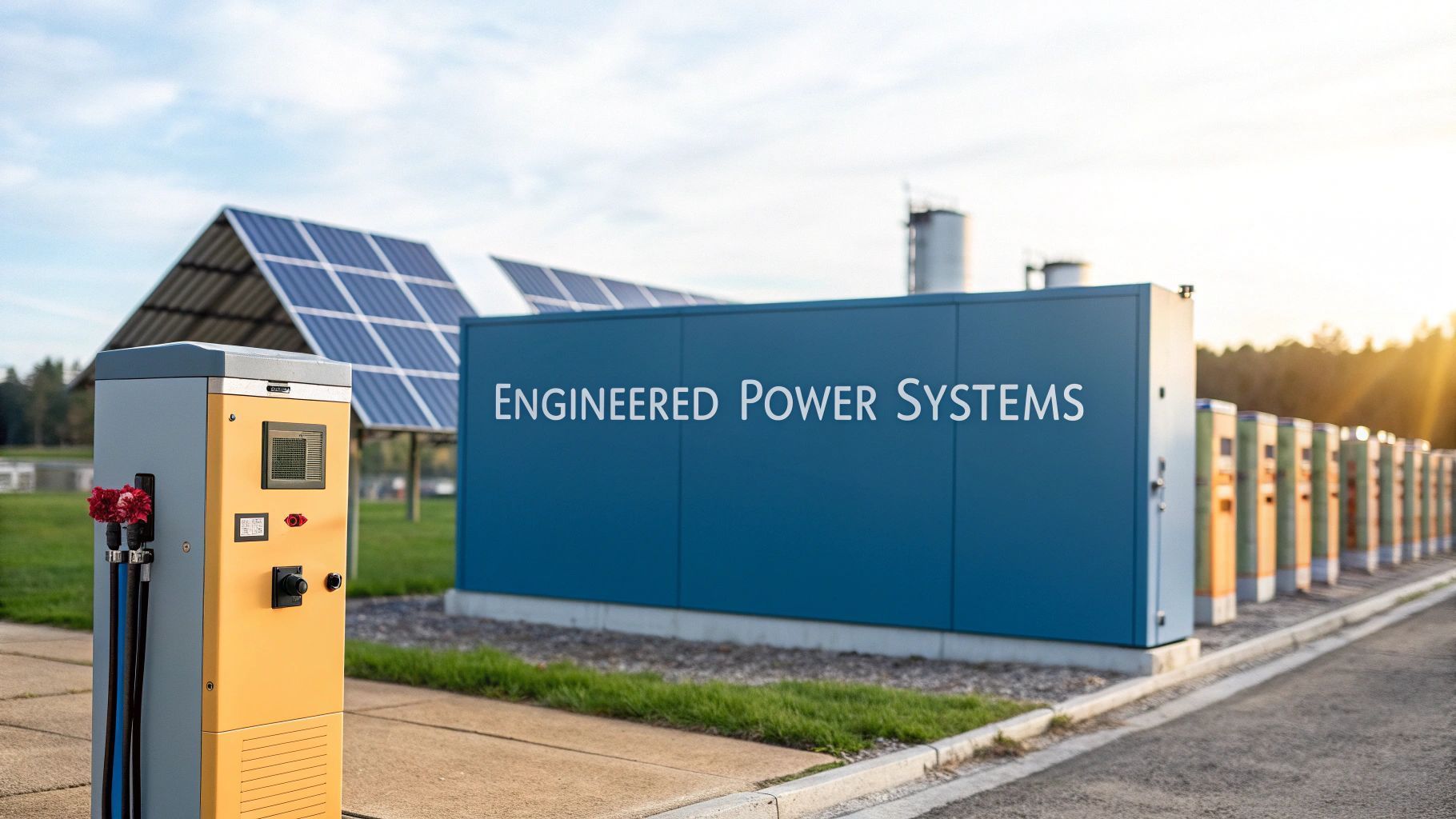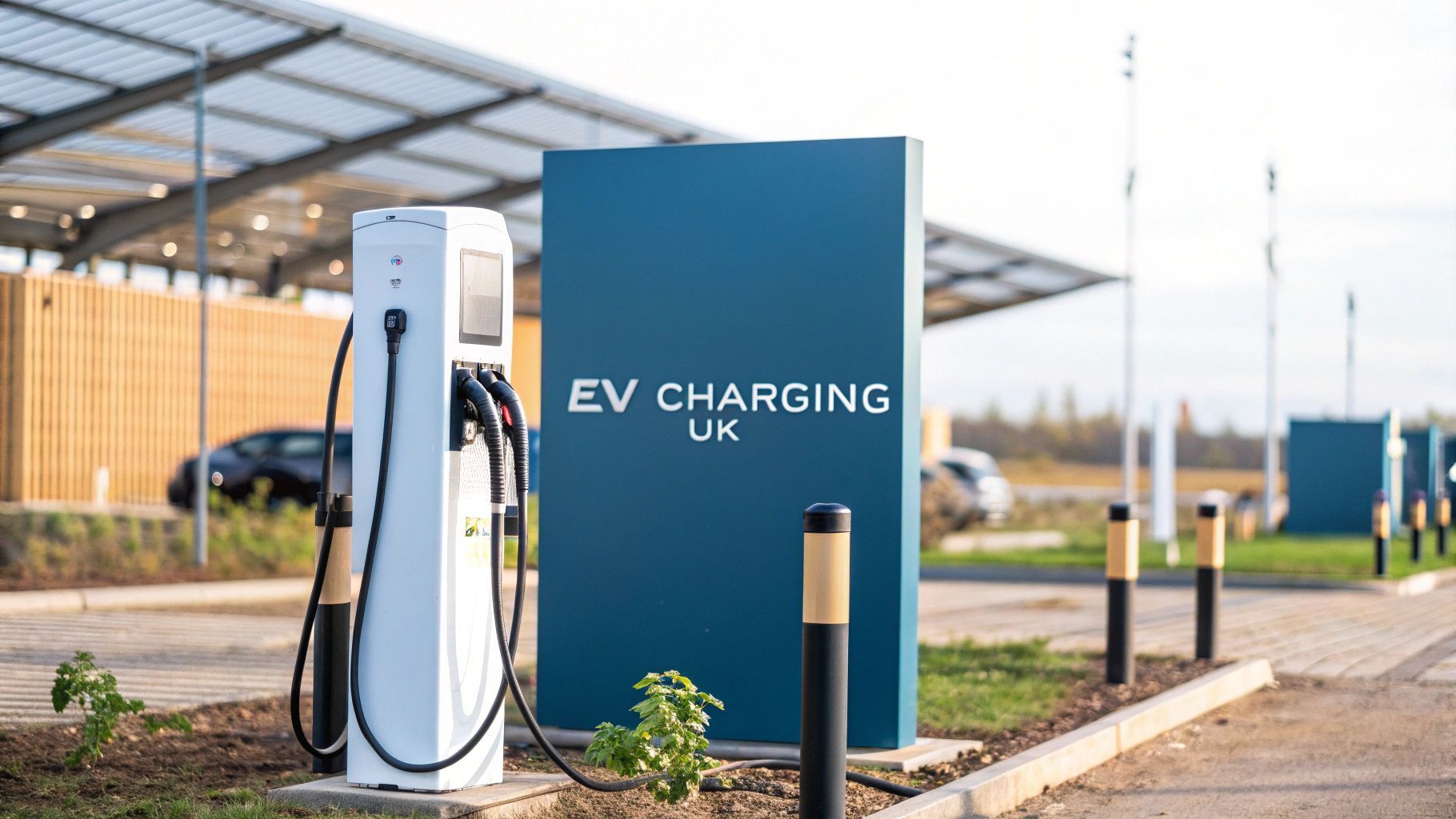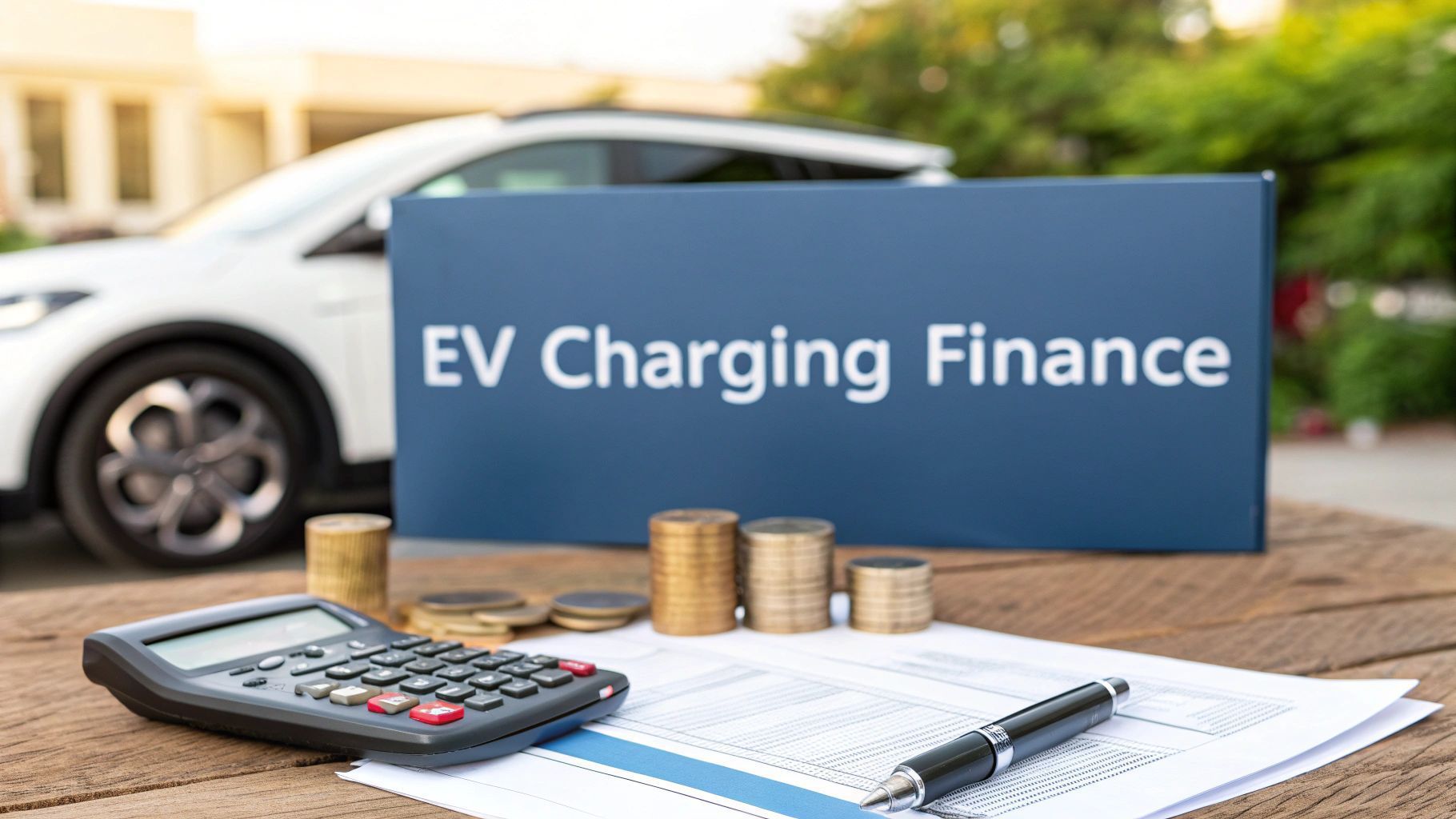Your Guide to UK DC Fast Charging
DC fast charging is changing the game for electric vehicles here in the UK. Think of it like this: filling up your EV is like filling a swimming pool. AC charging is your garden hose – great for a slow, steady top-up overnight but DC fast charging is the fire engine's hose – a massive blast of power that gets the job done in minutes.
It’s this speed that finally puts 'range anxiety' in the rear-view mirror and makes long-distance electric journeys a practical reality for everyone.
The UK's Rapid Shift to DC Fast Charging
The switch to electric vehicles is not some far-off concept anymore; it is happening right now on British roads. A huge part of this momentum comes from the rapid expansion of our public charging network, with DC fast charging right at its heart. This powerful infrastructure is quickly becoming the essential backbone for the growing number of EVs, helping the UK hit its ambitious environmental goals.
Unlike the slower AC charging you might have at home, DC fast charging is built purely for speed and convenience on the move. It skips the car's own internal converter and pumps high-voltage direct current straight into the battery. This simple change is what cuts charging times from hours down to just a few minutes.
A Network Built for the Future
The growth we have seen in the UK’s charging infrastructure has been nothing short of remarkable. To keep up with the booming EV market, the network of rapid and ultra-rapid chargers has expanded at a blistering pace. The latest figures really drive home how much progress has been made in a very short time.
The UK now has 8,619 ultra-rapid chargers (rated at 150 kW or more), which is a 23% increase in just six months . This is part of a wider public network that has grown to 82,369 charging units across the country. You can discover more about the expansion of EV charging in the UK from this recent report.
This rapid build-out is tackling one of the biggest worries for potential EV buyers: the fear of being stranded on a long journey with nowhere to recharge quickly. With high-power chargers popping up at service stations and dedicated hubs, electric motoring is becoming a genuinely viable option for everyone, not just city drivers.
Overcoming Grid and Energy Challenges
Of course, installing thousands of these high-power chargers is not without its headaches. Many ideal locations, particularly in more remote areas or older parts of our cities, just do not have the grid connection to handle the immense power draw. This is where we have to get smarter. To really scale up DC fast charging, we cannot just keep plugging into an already strained grid.
We need to think about integrated systems that include:
- Grid-scale batteries to store cheap, off-peak energy and release it when charging demand spikes.
- Combined on-site renewables , like solar panels, to generate clean power right where it is needed.
- Distributed energy systems that create resilient, self-sufficient charging ecosystems.
By pairing EV charging with batteries, it suddenly becomes possible to build rapid charging hubs without waiting for costly and time-consuming grid upgrades from constrained grid connections. This is not just a clever workaround; it is a fundamental shift needed to build a sustainable and scalable electric future for the UK.
How DC Fast Charging Technology Works
To get your head around why DC fast charging is so quick, you first need to understand a basic mismatch: the electricity from the grid and the electricity your car’s battery can actually store are speaking two different languages. The UK's national grid delivers power as an Alternating Current (AC) but your EV battery can only hold it as Direct Current (DC) .
Every electric car comes with an onboard charger , which is essentially a built-in translator. When you plug in at home or at a standard workplace charger, this small device takes the AC power and converts it into DC to fill the battery. Its size and power are limited, which is why this kind of charging can take hours.
A DC fast charger, on the other hand, is a whole different beast. It brings its own, much more powerful translator to the party. These big units contain a massive AC-to-DC converter, allowing them to completely bypass your car’s small internal system. They feed high-voltage DC power straight into your battery, slashing charging times from hours down to minutes.
The Great Connector Debate: CCS vs CHAdeMO
In the UK, you’ll mainly come across two different types of connectors for DC fast charging. They both get the job done but they are not interchangeable, so it is vital to know which one your car uses.
- CCS (Combined Charging System): This is now the go-to standard for pretty much every new electric vehicle sold in the UK and Europe. It gets the 'combined' part of its name from a clever design that merges both slow AC and rapid DC charging pins into one convenient plug.
- CHAdeMO: This standard was developed in Japan and was common on earlier EV models, like the first-generation Nissan Leaf. While you will still see CHAdeMO plugs at many charging stations, the industry has largely moved on and it’s being phased out in favour of CCS on new European cars.
Essentially, CCS has won the format war, which simplifies the public charging experience for most new EV drivers. Still, it’s always a good idea to double-check which connector your car needs before heading out on a long trip. For a more detailed technical dive, you can check out your guide to fast charger electric vehicle technology.
This image helps to visualise the simple and effective nature of modern rapid charging stations for electric vehicles.
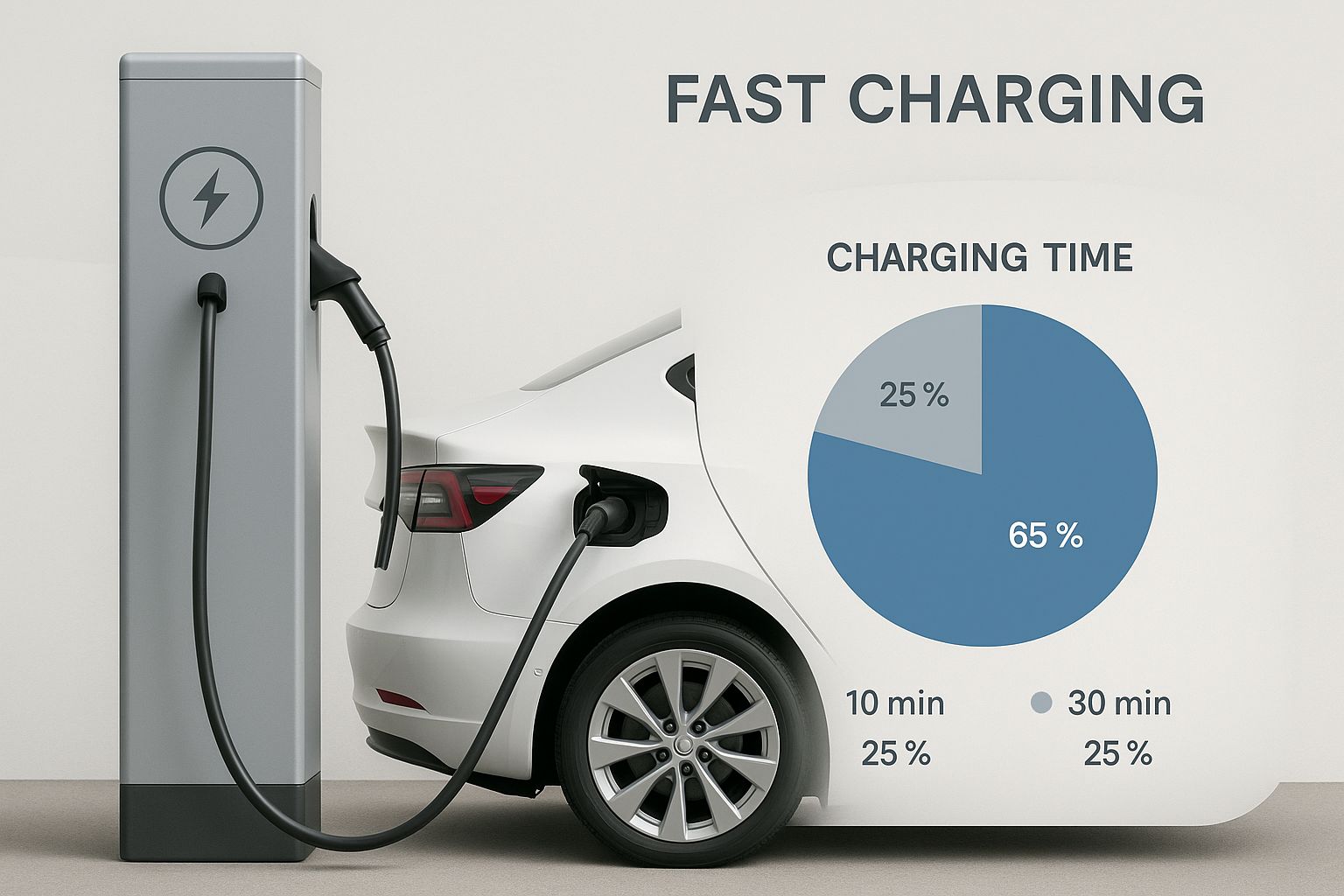
The depiction shows how seamless the connection is, highlighting the user-friendly design of today's fast charging points.
To make things clearer, here’s a quick comparison of the two main standards you'll encounter.
Comparing DC Fast Charging Standards in the UK
| Feature | CCS (Combined Charging System) | CHAdeMO |
|---|---|---|
| Connector Design | A single, integrated plug for both AC and DC charging. | A separate, larger plug used exclusively for DC charging. |
| Typical Power | Commonly supports 50kW up to 350kW and beyond. | Generally found at 50kW , with some older sites offering lower speeds. |
| Vehicle Compatibility | The standard for nearly all new European, Korean, and American EVs. | Primarily found on older Japanese models like the Nissan Leaf and Mitsubishi Outlander PHEV. |
| Market Trend | Dominant and growing across the UK and Europe. | Being phased out on new vehicles in the European market. |
As you can see, CCS is the clear winner for modern EVs, offering higher power and wider compatibility.
Understanding Power Levels from Rapid to Ultra-Rapid
Not all DC fast chargers deliver power at the same speed. Their output is measured in kilowatts (kW) and this figure directly impacts how quickly your car charges. Simply put, a higher kW rating means faster charging—as long as your car can handle it.
Here’s a rough guide to the charger types you’ll find on the UK network:
| Charger Category | Power Output (kW) | Typical Charging Time (10-80%) |
|---|---|---|
| Rapid | 50kW | 40-60 minutes |
| Ultra-Rapid | 100kW - 175kW | 20-40 minutes |
| Ultra-Rapid+ | 350kW+ | 15-25 minutes |
While plugging into a mighty 350kW charger sounds great, it is crucial to remember that your car is the one calling the shots. An EV with a maximum charge rate of 100kW will only ever draw 100kW , even from a more powerful unit. The car’s battery management system is in constant communication with the charger, ensuring it only pulls power at a rate that is both safe and optimal for the battery's health.
Solving Grid Constraints with Smart Energy Solutions
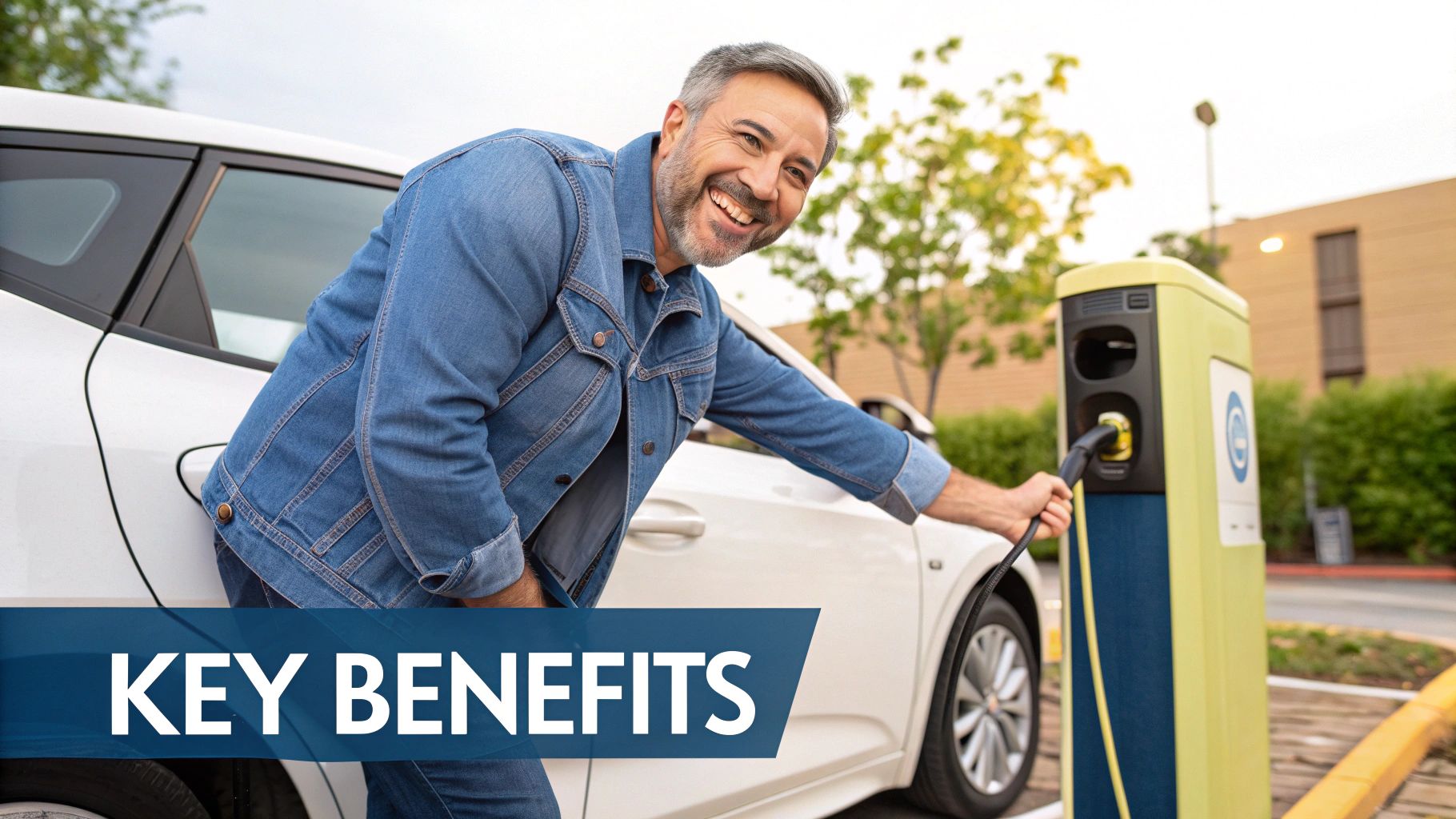
The incredible power of dc fast charging comes with a serious catch. Installing a bank of rapid chargers places an immense, simultaneous demand for electricity on the local grid—a demand it often cannot handle. This problem, known as a constrained grid connection , is one of the biggest hurdles slowing down the expansion of the UK’s charging network.
Picture a rural service station or a city-centre car park wanting to install ten ultra-rapid chargers. The moment those chargers power up, they could pull more electricity than the entire surrounding neighbourhood. This sudden spike can easily overwhelm local transformers and cables, making new installations impossible without hugely expensive and time-consuming grid upgrades.
These upgrades can take months, sometimes years, to complete and frequently cost more than the charging hardware itself. It is a single issue that often stalls promising projects, especially in the very areas that need rapid charging the most. Thankfully, there’s a smarter way to sidestep this problem entirely.
Introducing Battery Energy Storage Systems
The game-changing solution is the Battery Energy Storage System (BESS) . Think of a BESS as a local energy reservoir—a powerful buffer that sits between the chargers and the delicate local grid. It completely redefines the relationship between a charging hub and the wider electricity network.
Instead of yanking a massive amount of power from the grid all at once when cars plug in, the BESS can be charged slowly and strategically. It can fill up during off-peak hours when electricity is cheaper and demand is low, or it can draw power directly from on-site renewables like solar panels.
When a fleet of EVs arrives needing a rapid top-up, the BESS simply discharges its stored energy at high speed, delivering the necessary power without putting any sudden strain on the grid connection.
This clever decoupling of charging demand from grid supply makes rapid EV charging hubs viable even in locations with weak or non-existent high-capacity grid infrastructure. It transforms a potential roadblock into a manageable engineering challenge.
By integrating a BESS, developers can deploy powerful dc fast charging hubs almost anywhere. This unlocks countless new sites and accelerates the build-out of a truly national charging network, bridging the gap between urban centres and more remote regions.
Creating a Resilient Charging Ecosystem
Pairing dc fast charging with a BESS does more than just solve the grid constraint problem; it creates a more resilient, efficient, and self-sufficient charging ecosystem. This integrated approach is a cornerstone of modern distributed energy strategies.
This combination of technologies allows a charging hub to operate more like a self-contained microgrid.
- Combined On-site Renewables: Combining chargers and batteries with solar carports or rooftop panels means the hub can generate and store its own clean energy. This reduces reliance on grid electricity and brings down running costs.
- Mobile EV Charging: For temporary needs or locations where fixed infrastructure is impractical, mobile EV charging units powered by their own integrated batteries can be deployed. These offer flexible rapid charging without any grid connection at all.
- Grid Scale Support: A large BESS at a charging hub can do more than just power cars. It can also participate in grid services, helping to stabilise the national network by providing power during moments of high demand and earning revenue in the process.
This intelligent mix of EV charging and batteries moves far beyond a simple plug-and-socket model. It creates a dynamic energy asset that supports drivers, lowers operational costs and contributes to a more stable and sustainable national energy system.
The Business Case for BESS-Powered Charging Hubs
Beyond the technical wizardry, does integrating a Battery Energy Storage System (BESS) with DC fast chargers actually make good financial sense? The answer is a resounding yes. The business case is not just strong; it is built on two powerful pillars: massive cost avoidance and the creation of entirely new revenue streams that turn a charging hub into a dynamic energy asset.
The most immediate financial win comes from sidestepping the crippling expense of grid reinforcement. For many potential charging sites, the cost to upgrade the local electricity network to handle the immense power draw of rapid chargers can actually exceed the cost of the charging hardware itself. That single factor can make a project financially unviable before it even gets off the ground.
A BESS solves this problem by creating a powerful local energy buffer. It allows a site to connect to a much weaker, and therefore cheaper, part of the grid. By slowly trickle-charging the battery during off-peak hours and then discharging that power rapidly to vehicles when needed, it completely avoids the need for those eye-watering grid upgrades.
Unlocking Diverse Revenue Streams
A BESS-powered hub earns money in far more ways than just selling electricity to drivers. This diversification is the secret to building a resilient and profitable business model, transforming the site from a simple energy consumer into an active participant in the national energy market.
One of the most valuable functions is peak shaving . Electricity prices swing wildly throughout the day, with costs soaring during peak demand periods. A BESS allows you to draw cheap electricity from the grid overnight, store it and then use that stored energy to power the chargers during expensive peak times. This simple strategy means you avoid high tariffs and can dramatically lower your operational energy bills.
This strategic energy management is a core benefit of combining EV charging and batteries . Find out more about how battery storage systems are powering the UK’s EV revolution and making this financial model possible.
By actively managing its energy, a BESS-powered charging hub can slash its reliance on expensive peak-rate grid electricity by over 80% . It turns a major operational cost into a controllable expense.
Participating in Grid Services
Beyond the on-site savings, a BESS can generate direct income by supporting the National Grid. These are known as grid services and they are vital for keeping the UK's power supply stable as more renewable energy comes online. For those looking to invest in these sophisticated systems, understanding the available financial tools is crucial. You can explore a guide to securing equipment financing loans for essential infrastructure projects like these.
A charging hub’s BESS can take part in several lucrative schemes:
- Frequency Response: The grid must maintain a constant frequency. If it deviates, the BESS can instantly inject or absorb power to help stabilise it, earning payments just for being on standby and for every time it acts.
- Capacity Market: This is a mechanism where energy providers are paid to guarantee they can deliver power during periods of high national demand. A BESS can commit its stored capacity to this market, providing a steady and reliable income stream.
These services create a powerful financial roadmap. When you combine the avoided grid costs, reduced energy bills, revenue from drivers and income from grid services, a BESS-integrated DC fast charging hub becomes a highly attractive and future-proof investment. It’s no longer just about charging cars; it’s about building a smarter, more profitable energy future.
Mapping the UK's EV Charging Divide
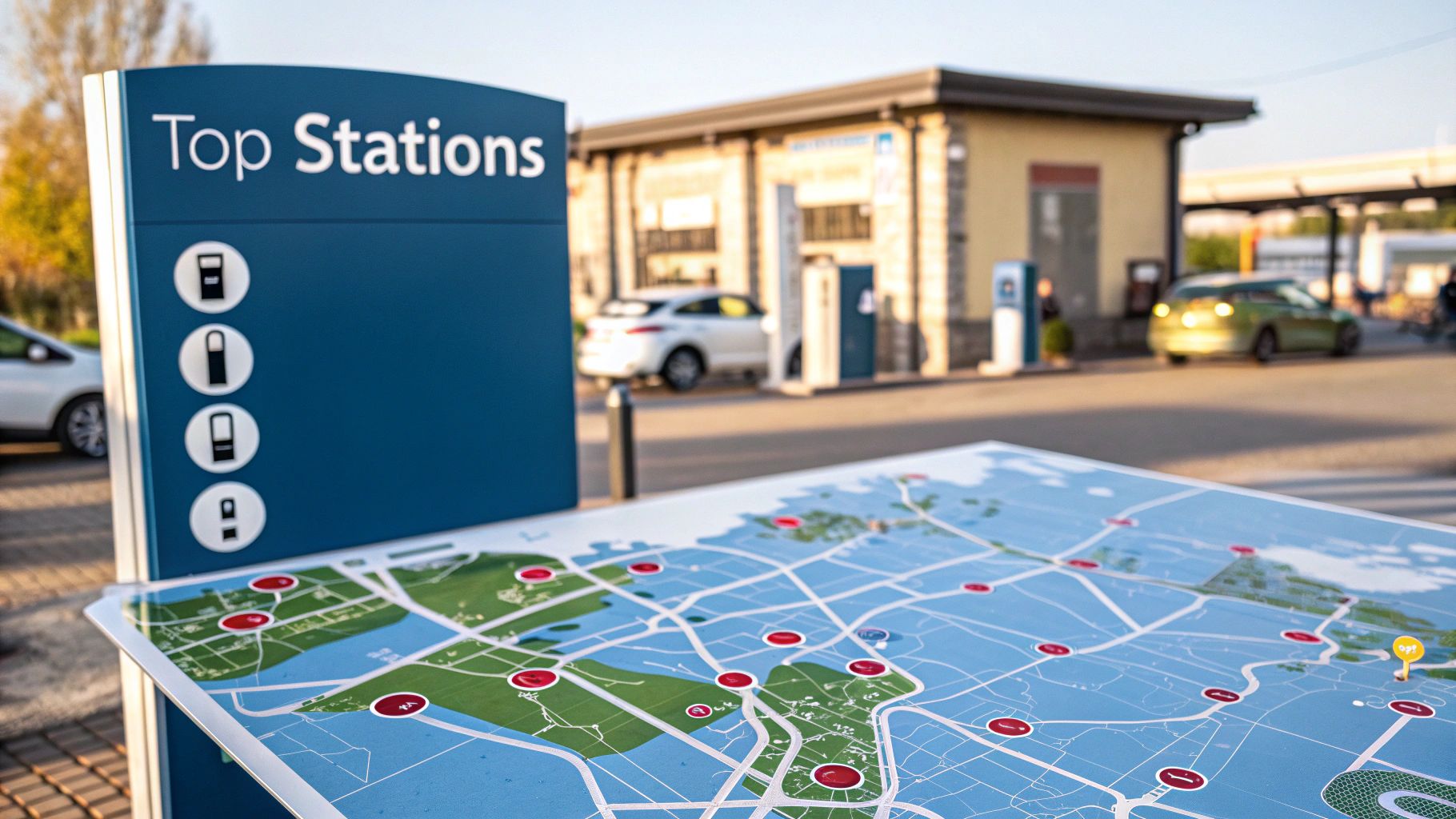
While it is great to see the national numbers for rapid EV charging climbing, the reality on the ground is far from uniform. Where you live in the UK often determines just how easy it is to find a DC fast charging point, creating a genuine geographical divide. People often call this a 'postcode lottery' and it really highlights the challenge of building a national network that works for everyone.
The difference between regions is stark. Big urban centres, especially Greater London, are packed with charging options, making EV ownership pretty straightforward but that level of convenience is not shared across the country, with many rural areas and some devolved nations lagging well behind.
London's Charging Dominance
Greater London is the undisputed leader in the UK's public EV charging scene. The capital has seen concentrated investment and has a high population density, creating a network that simply dwarfs other regions. It is not just about the total number of chargers; it’s the provision per person that truly sets it apart.
The city is home to over 25,502 public EV charging devices , which makes up roughly 30% of the entire UK network . Look at it on a per capita basis and London still leads with 263 devices per 100,000 people —more than double any other region. You can discover more insights about these EV charging statistics to see the full regional breakdown for yourself.
This concentration comes down to a few key factors:
- Targeted Investment: Proactive policies from local government combined with private investment have put deployment on the fast track.
- Population Density: More people and more vehicles mean a stronger business case for charging operators.
- Grid Capacity: Urban areas tend to have more robust grid connections that can handle the demands of rapid charging hubs.
Addressing the Regional Imbalance
This imbalance is a major hurdle. For the UK to fully switch to electric transport, drivers everywhere need reliable access to rapid charging. The current situation risks leaving entire communities behind, making EV ownership impractical for anyone outside the well-served city hubs. If you want a detailed look at the different providers, you might find our guide explaining the UK electric vehicle charging networks useful.
The core challenge isn’t just about installing more chargers; it’s about installing them in the right places. This means we have to overcome grid constraints, particularly in rural locations where the local network is often too weak for high-powered DC fast charging .
This is where solutions like combining EV charging and batteries become so important. By deploying Battery Energy Storage Systems (BESS), it’s possible to install rapid chargers even in areas with shaky grid connections. The technology allows energy to be stored during off-peak times and then released quickly when an EV plugs in, making it a key piece of the puzzle for levelling up the UK’s charging map and making sure no driver gets left behind.
When we look past today's charging technology, it is clear that EV charging is becoming the backbone of a smarter, more decentralised energy system. This is not just about plugging in your car faster; it is about weaving transport and energy into a single, cohesive network. The future is all about distributed energy resources—a system where thousands of EV chargers, grid scale batteries and combined on-site renewables all work in concert.
Imagine all these individual pieces—a charging hub here, a solar farm there, a bank of batteries somewhere else—all connected and talking to each other. When they act together, they can function like one huge virtual power plant. This gives the national grid a level of stability and flexibility that was simply impossible before, helping it manage the huge new demand from electric transport.
The Rise of Vehicle-to-Grid Technology
One of the most exciting developments is Vehicle-to-Grid (V2G) technology. The idea behind it is simple but incredibly powerful: a parked EV does not have to just sit there. With V2G, your car's battery can actually send power back to the grid during peak demand, turning every vehicle into a mobile energy storage unit.
Think about it: most cars are parked for over 95% of their lives. If thousands, or even millions, of these EVs are plugged in, they represent a vast, untapped energy reserve. This network of mobile EV charging batteries could be used to smooth out the daily peaks and troughs in energy supply, which is especially important as we rely more on intermittent renewables like wind and solar.
Vehicle-to-Grid completely changes the relationship between car owners and the energy market. By letting the grid draw small amounts of power from their car battery when it is most needed, drivers could earn money, effectively lowering their car's total cost of ownership.
This system creates a genuine two-way street for electricity. Instead of just taking power, EVs become active players in the grid, helping to build a more stable and resilient energy infrastructure for everyone.
Megawatt Charging for Heavy Goods Vehicles
The same principles of DC fast charging are also being scaled up to tackle much bigger challenges. The next frontier is megawatt charging , designed specifically for the lorries, buses and other heavy goods vehicles that keep our economy moving. These vehicles have enormous batteries and need a colossal amount of power to recharge quickly enough to keep logistics on schedule.
Megawatt Charging Systems (MCS) are now being developed to deliver power at rates of 1MW and higher. This kind of power would allow a heavy-duty electric lorry to add hundreds of miles of range during a driver's mandatory rest break. This level of rapid EV charging is absolutely essential to make the electrification of commercial transport a practical reality.
- Speed: The goal is to make recharging an electric lorry just as fast as refuelling a diesel one.
- Infrastructure: This requires incredibly robust grid connections or, more likely, large on-site grid scale batteries to buffer the immense power draw.
- Combined Renewables: These charging hubs will almost certainly need to integrate on-site solar or wind to help generate the vast amounts of electricity required.
A Truly Interconnected Future
As these technologies mature, the line between transport and energy will continue to blur. Your car will become more than just a way to get from A to B; it will be an active component of the energy grid. Charging hubs will evolve from simple refuelling stops into sophisticated energy hubs, managing power from constrained grid connections , storing it in batteries and even selling services back to the grid.
This vision of a distributed energy future, powered by EV charging and batteries , is already starting to take shape. It promises a more efficient, resilient and sustainable system where energy is generated, stored and used locally—creating a truly interconnected network fit for the twenty-first century.
Common Questions About DC Fast Charging
As rapid EV charging pops up everywhere across the UK, it’s only natural for drivers to have questions about how it all works. Getting your head around the technology is the best way to get the most out of your electric vehicle on every journey. We have pulled together some of the most common questions to give you clear, straightforward answers.
How Long Does It Really Take To Charge?
This really comes down to three things: your car’s battery size, how full it is when you plug in and the charger’s power output. A modern EV can often get 100-200 miles of range in just 20-30 minutes if you’re hooked up to an ultra-rapid (150kW+) charger.
It is important to remember that the charging speed slows down dramatically once the battery hits about 80% . This is not a fault; it’s a built-in safety feature designed to protect the battery’s long-term health. Because of this, charging from 10-80% is always much quicker than waiting for that last 20% to trickle in.
Can Any Electric Car Use Any DC Fast Charger?
No, you have got to have the right connection. Most new electric vehicles sold in the UK and Europe today use the CCS (Combined Charging System) standard, which has pretty much become the go-to. However, you’ll still find some older models, especially from Japanese manufacturers like Nissan, that use the CHAdeMO standard.
While many charging stations have both connectors to cover all bases, CCS is definitely the dominant format now. It’s always a good idea to check your car's connection type and what’s available at a charging station before you rely on it for a long trip.
Is Using DC Fast Charging Bad For My EV Battery?
Constantly relying only on DC fast charging can speed up battery degradation over time compared to slower AC charging. The simple reason is heat. Pushing that much power in so quickly generates more heat, which puts a bit more stress on the battery cells.
The best approach for keeping your battery healthy is to use slower AC charging for your day-to-day needs, like overnight at home. Save the rapid DC charging for long journeys or when you’re caught short and need a quick top-up.
This balanced method gives you the convenience of speed when you need it, without chipping away at your battery's lifespan.
Why Is DC Fast Charging More Expensive Than Home Charging?
The higher price of public rapid EV charging is not just for show; it reflects the huge investment needed to build and run the infrastructure. The costs are significant and break down into a few key areas.
- Expensive Hardware: The high-power converters and cooling systems inside DC chargers are complex, specialised pieces of kit and they do not come cheap.
- Installation and Grid Connection: Hooking up a high-power charger to the national grid is a major undertaking, often requiring expensive electrical upgrades to the local network.
- Operational Costs: On top of the hardware, there are ongoing costs like site rental, regular maintenance and network software fees that all get factored into the final price you pay per kWh.
Ultimately, you’re paying for the incredible convenience of adding hundreds of miles of range in the time it takes to grab a coffee. Home charging, on the other hand, sips low-cost, off-peak electricity over many hours.
At ZPN Energy , we provide the advanced charging and battery storage solutions that power the UK's electric future. Our integrated systems overcome grid constraints to deliver reliable, rapid charging anywhere. Explore our cutting-edge energy management technologies at https://www.zpnenergy.com.


